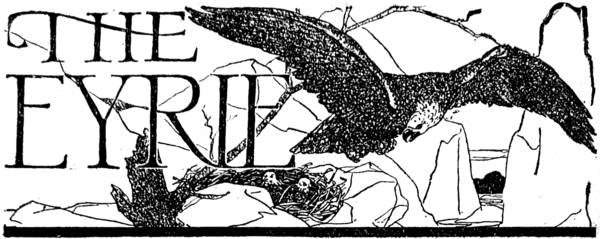
Since the death of H. P. Lovecraft last March, there has been a growing demand for a book collection of his marvelous stories. Now it seems that Mr. Lovecraft's admirers will have their wish; for Donald Wandrei and August W. Derleth are preparing a collection of his tales, prose miscellany, poems, and letters, which will run to at least four volumes. Mr. Lovecraft's letters give an insight into the man's character, and show his kindliness, his scholarly qualities, and his keen incisive analytical ability and unerring literary judgment. If any among you, our readers, have in your possession any interesting letters from Mr. Lovecraft, Messrs. Wandrei and Derleth would like to see them. You will be doing a service to the memory of a great literary artist by calling these letters to the attention of August W. Derleth, whose address is Sauk City, Wisconsin.
In Memoriam
Mrs. Hazel Heald writes from Newtonville, Massachusetts: "A brain like H. P. Lovecraft's seldom was found—uncanny in its intelligence. He was ever searching for more knowledge, gleaning by endless hours of study a richer and fuller understanding of people and of life. Being a great traveler, he reveled in the study of old cities and their hidden lore and would walk many miles to inspect some historic spot. He was a real friend to all who knew him, always ready to give his valuable time to aid some poor struggling author—a true guiding star. He was very partial to dumb animals, especially cats, signifying that interest in several of his tales. He would step out of his way to pat some forlorn alley cat and give it a friendly word, and the kittens of a neighbor furnished him unbounded enjoyment. He was an ardent lover of architecture and all the fine arts, and a day spent in a museum with him was time well spent. By endless hours of toil he worked far into the night giving the world masterpieces of weird fiction, sacrificing his health for his work. Lovecraft was a gift to the world who can never be replaced—Humanity's Friend."
Removed from the Stands
John V. Baitadonis, of Philadelphia, writes: "Although I read the June issue the first day it came out, this is the first opportunity I have had to type my usual letter to the Eyrie. However, as the motto goes, 'Tis better late, than never.' The cover by Brundage is beautiful. However, if you continue to have such covers, I'm afraid I'll be unable to obtain Weird Tales. Over here in Philly, they're collecting all magazines that display unclad females for fear that the police will seize them. There is some kind of law over here prohibiting the sale of pornographic literature—however, I'm sure that if the inspectors would read the interior of the magazine, they'd find nothing wrong with it. . . . I hope that I can obtain my July issue. If not, I suppose I'll have to subscribe, for nothing can keep me from reading Weird Tales! To get down to the rest of the magazine, however: The Black Kiss by Robert Bloch and Henry Kuttner is a gem of a story—it is undoubtedly the best complete story in the issue. The end of the tale is altogether different from what I had expected it to be—that in itself made it a 'different' story. The Carnal God by John R. Speer and Carlisle Schnitzer is another swell story, and closely follows The Black Kiss in the race for first place. Clicking Red Heels by Paul Ernst is another fine yarn. However, Mr. Ernst, what has become of that arch-villain, Doctor Satan? The serial is superb. The issue as a whole is excellent,
